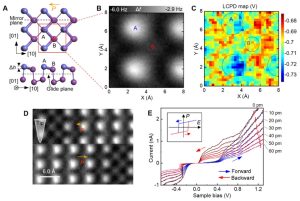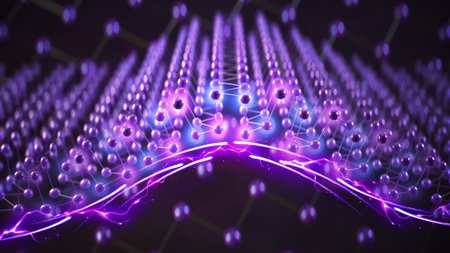National University of Singapore: Novel Ferroelectric Material for Future of Storage Solutions
Ferroelectric materials can generate electric field and offer several benefits, such as high writing speed for data storage, high storage density, lower operating power, and ability to retain data without power source.
This is a Press Release edited by StorageNewsletter.com on April 11, 2023 at 2:01 pmFrom National University of Singapore (NUS)
Since its discovery more than 100 years ago, ferroelectric materials still garner much attention in research due to their wide-ranging applications, from data storage to renewable energy systems. They can generate an electric field and offer several benefits, such as high writing speed for data storage, high storage density, lower operating power, and the ability to retain data without a power source.
Figure schematically illustrates that monolayer of single-element bismuth
contains 2 different types of ions that switches polarity
with each other as the domain wall moves.
2D ferroelectric materials are an emerging type of ferroelectric material. However, R&D in this area is limited due to the small number of available materials.
Adding to the current library of 2D ferroelectric materials, physicists from NUS have recently discovered a new single-element material, known as 2D black phosphorus-like bismuth (BP-Bi), that demonstrates ferroelectric properties. This new material changes the conventional understanding of ferroelectric materials, which are commonly made up of compounds – more than one element – with opposing charges to allow the formation of an electric field. This finding solves the fundamental question of whether single-element substances have ferroelectric properties.
This ground-breaking discovery was achieved by a team led by Professor Andrew Wee, Department of Physics, NUS Faculty of Science, with collaborators Professor Chen Lan, Institute of Physics, Chinese Academy of Sciences, and Professor Lu Yunhao, School of Physics, Zhejiang University. Findings of this novel ferroelectric material were published in Nature on April 5, 2023.
The researchers used techniques to visualise in detail the single-element material, BP-Bi, at an atomic scale. Through experimental methods, they observed a new form of ferroelectricity within the structure of BP-Bi, which an external source of electricity can control.
The researchers shared that this form of ferroelectricity will have implications for future quantum electronic devices and advanced data storage devices. This new single-element ferroelectric material also provides a fresh perspective to studying the basic physical properties of elements.
Wee said: “In addition to overturning the common-sense idea that ionic polarisation only exists in compounds, we believe that single-element ferroelectricity in BP-Bi would introduce a new perspective to the study and design of novel ferroelectric materials, and inspire new physics of elemental materials in the future.”
Discovery of ferroelectricity in an elementary substance
Due to the potential applications for data storage, ferroelectric materials have attracted widespread research attention.
NUS physicists have discovered a novel form of ferroelectricity in a single-element bismuth monolayer that can produce regular and reversible dipole moments for future applications of non-volatile memories and electronic sensors.
Ferroelectricity refers to the phenomenon of certain materials exhibiting a spontaneous electric polarisation that can be reversed by applying an external electric field. Ferroelectric materials are characterised by a crystal structure that lacks a centre of symmetry.
Due to the potential applications for data storage, they have attracted widespread research attention. Besides, their piezoelectric, thermoelectric and nonlinear optical properties have been extensively studied in research areas such as renewable energy, micro-electro-mechanical systems and optical devices. In recent years, 2D ferroelectric materials have emerged as a new contender in the field of neuromorphic synapse devices, displaying the advantage of low dimensionality. However, the development of 2D ferroelectric materials is still limited due to the small number of available materials.
Ferroelectricity commonly occurs in compounds composed of multiple constituent elements, where the gain and loss of electrons between the constituents promotes the formation of positive and negative ions in the crystal. Regular atom distortion or charge ordering between sublattices leads to the breaking of the central symmetry, thus promoting the formation of ferroelectric polarisation.
Recently, a research team led by Wee, made a breakthrough discovery of the single-element ferroelectric state in 2D black phosphorus-like bismuth (BP-Bi), overturning the traditional understanding of ferroelectricity mentioned above. By using optimised scanning tunnelling microscopy (STM) and non-contact atomic force microscopy (nc-AFM) techniques, the researchers did a detailed observation of the centrosymmetry-breaking on the atomic structure and charge transfer between sublattices in BP-Bi. For the first time, the single-element ionicity, single-element in-plane polarisation and single-element ferroelectricity were all demonstrated in the bismuth monolayer experimentally. This discovery changes the concept that ionic polarisation only exists in compounds with cations and anions, and expands the scope of ferroelectricity development in the future. This work is undertaken in collaboration with Professor Lan Chen, Institute of Physics, Chinese Academy of Sciences, and Professor Yunhao Lu, School of Physics, Zhejiang University. The findings were published in Nature (see below).
The researchers prepared the high-quality BP-Bi on the Van der Waals graphite surface so that the monolayer BP-Bi is intact and flat enough for the measurements. Taking advantage of the high spatial resolution of nc-AFM, the buckling atomic configuration (Dh≠0) of BP-Bi, as well as the charge redistribution between the two sublattices were determined by AFM imaging and Kelvin probe microscopy (KPFM) measurements. Thereafter, a regular in-plane dipole arrangement is confirmed in the BP-Bi monolayer. In comparison, single layer phosphorous (phosphorene) has no buckling in each sub-layer – therefore it is centrosymmetric and nonpolarised. Then, polarisation switching of BP-Bi is realised by using the in-plane electric field produced by the STM tip, which is the basis for writing on the non-volatile memory devices.
Ferroelectricity relative to magnetism is advantageous for its manipulation by only the electric field. This makes it more suitable to be contained in integrated circuit devices. Many studies found that it is possible to manipulate other material attributes by coupling ferroelectricity with these properties. In BP-Bi, the buckling degree of atomic structure determines the ferroelectric polarisation and, at the same time, controls the basic band structure. This results in an interlock between the electronic structure and ferroelectric polarisation. This new type of ferroelectricity offers a promising way to modulate the electronic structure of materials by an external electric field through ferroelectric distortion.
Dr Jian Gou, lead author, research paper, said: “Other research has also shown that BP-Bi exhibits topologically nontrivial states at a specific buckling height, suggesting a potential opportunity for tuning topological states through an electric field.”
In fact, the polarisation characteristics have a critical impact on the basic optical and electrical properties of materials. The discovery of single-element ferroelectric polarisation adds a new viewpoint to the study of the basic physical properties of elementary substances.
Wee said: “In addition to overturning the common-sense idea that ionic polarisation only exists in compounds, we believe that single-element ferroelectricity in BP-Bi would introduce a new perspective to the study and design of novel ferroelectric materials, and inspire new physics of elemental materials in the future.”
Figure (A) shows the ball-and-stick model of black phosphorus-like bismuth (BP-Bi) with top view (top panel) and side view (bottom panel). Different from black phosphorous, BP-Bi has a nonzero buckling Dh. Figure (B) and (C) show the typical non-contact atomic force microscopy (nc-AFM) image and Kelvin probe microscopy (KPFM) map of the same location respectively. Figure (D) represents the domain wall movement detected by nc-AFM when performing the polarisation switching. The top and bottom halves are the images acquired after forward and backward bias sweeping respectively. Figure (E) is the tip-height dependence of the current during the bias sweep.
Click to enlarge
 References:
References:
Gou J*; Bai H; Zhang X; Huang YL; Duan S; Ariando A; Yang SA; Chen L*; Lu Y*; Wee ATS*, “Two-Dimensional Ferroelectricity in a Single-Element Bismuth Monolayer” NATURE DOI: 10.1038/s41586-023-05848-5 Published: 2023.
Gou J; Kong L; He X; Huang YL; Sun J; Meng S; Wu K; Chen L*; Wee ATS*, “The Effect of Moiré Superstructures on Topological Edge States in Twisted Bismuthene Homojunctions” SCIENCE ADVANCES Volume:6 Issue:23 Article Number: eaba2773 DOI: 10.1126/sciadv.aba2773 Published: 2020.
Article:Two-dimensional ferroelectricity in a single-element bismuth monolayer
Nature has published an article written by Jian Gou, Department of Physics, National University of Singapore, Singapore, Singapore, Hua Bai, Zhejiang Province Key Laboratory of Quantum Technology and Device, School of Physics, State Key Laboratory of Silicon Materials, School of Materials Science and Engineering, Zhejiang University, Hangzhou, China, and Department of Physics, Faculty of Science, Kunming University of Science and Technology, Kunming, China, Xuanlin Zhang, Zhejiang Province Key Laboratory of Quantum Technology and Device, School of Physics, State Key Laboratory of Silicon Materials, School of Materials Science and Engineering, Zhejiang University, Hangzhou, China, Yu Li Huang, Joint School of National University of Singapore and Tianjin University, International Campus of Tianjin University, Fuzhou, China, Sisheng Duan, A. Ariando, Department of Physics, National University of Singapore, Singapore, Singapore, Shengyuan A. Yang, Research Laboratory for Quantum Materials, Singapore University of Technology and Design, Singapore, Singapore,Lan Chen, Institute of Physics, Chinese Academy of Sciences, Beijing, China, and School of Physics, University of Chinese Academy of Sciences, Beijing, China, Yunhao Lu, Zhejiang Province Key Laboratory of Quantum Technology and Device, School of Physics, State Key Laboratory of Silicon Materials, School of Materials Science and Engineering, Zhejiang University, Hangzhou, China, and Andrew Thye Shen Wee, Department of Physics, National University of Singapore, Singapore, Singapore, and Centre for Advanced 2D Materials (CA2DM) and Graphene Research Centre (GRC), National University of Singapore, Singapore, Singapore.
Abstract: “Ferroelectric materials are fascinating for their non-volatile switchable electric polarizations induced by the spontaneous inversion-symmetry breaking. However, in all of the conventional ferroelectric compounds, at least two constituent ions are required to support the polarization switching1,2. Here, we report the observation of a single-element ferroelectric state in a black phosphorus-like bismuth layer3, in which the ordered charge transfer and the regular atom distortion between sublattices happen simultaneously. Instead of a homogenous orbital configuration that ordinarily occurs in elementary substances, we found the Bi atoms in a black phosphorous-like Bi monolayer maintain a weak and anisotropic sp orbital hybridization, giving rise to the inversion-symmetry-broken buckled structure accompanied with charge redistribution in the unit cell. As a result, the in-plane electric polarization emerges in the Bi monolayer. Using the in-plane electric field produced by scanning probe microscopy, ferroelectric switching is further visualized experimentally. Owing to the conjugative locking between the charge transfer and atom displacement, we also observe the anomalous electric potential profile at the 180° tail-to-tail domain wall induced by competition between the electronic structure and electric polarization. This emergent single-element ferroelectricity broadens the mechanism of ferroelectrics and may enrich the applications of ferroelectronics in the future.“














 Subscribe to our free daily newsletter
Subscribe to our free daily newsletter
